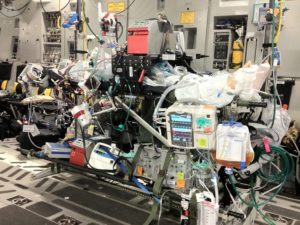Mr and Mrs Lee have been married for 62 years. They have two adult children, and have been in fairly good health. Mrs. Lee is 84 and has some osteoporosis and arthritis. Mr Lee is 87 and has had high blood pressure for some years and has a history of heart disease that has been treated with medication and diet. Mr Lee recently had an episode of congestive heart failure after going out to dinner and getting too much sodium. He is in the hospital and both children have arrived to assist with care planning for their parents.

The doctors and social workers sit down with Mr Lee and his children to discuss advanced directives, which neither parent have ever had. It is explained that while states may have some variation in how they are written and executed, what an advanced directive does is provide direction to your care team on your wishes as well as designating who you wish to speak on your behalf if you cannot. Advanced directives are very helpful to your designated decision maker as well, since they specify what YOUR wishes are and assist them in making those decisions. The scope of the advanced directive (or ‘Living Will’) is to specify what potentially life extending measures you would wish should you be unable to speak for yourself. Common instances would be a stroke that renders you unable to communicate and swallow, or to breathe unassisted.
There are specific measures that you will find in these documents.
Artificial feeding – which can include a tube (link is video that may be TMI) through the nose and into the stomach, a tube directly into the stomach or small intestine, or nutrition given through an IV line.
Artificial hydration – which generally means IV fluids if used alone, but fluids are also part of the nasal or gastric feedings if those are chosen. Another, less common method of treating moderate dehydration is hypodermoclysis – fluid is inserted under the skin (subcutaneously) where it can be slowly absorbed by the body. This is also used palliatively since it can be easier to accomplish in a home situation where the patient does not have an IV line.
Mechanical assistance to breathe – Intubation is the process of placing a breathing tube to keep your airway open. Ventilation is the process of forcing air through that tube under pressure to breathe for you, and a respirator is the machine that is used to do this. For long term, a tracheotomy is usually performed so the respirator can be connected at the neck, freeing up the mouth and throat.
Your advanced directive may also specify things like kidney dialysis, where your body is hooked up to a dialysis machine and your blood is run through the machine to filter out all the toxins and restore the balances that your kidneys normally perform.
Cardiopulmonary Resuscitation (CPR) – This ranges from the CPR you see done in the field with a person doing chest compressions and breaths for someone whose heart has stopped, to the use of an AED (Automatic External Defibrillator), up to a full medical cardiac resuscitation with a crash cart, hospital defibrillation, and drugs.

All the above measures are intended to prolong life or delay death – BUT – they are all supportive measures, not a magical ‘machine’ that can keep one alive indefinitely. This is a very common misconception that I have encountered that is, sadly, often spread further by popular media. The idea that if we keep pumping food, fluids and oxygen into someone they won’t die. I invite folks to think about how many 300 year old people with feeding tubes and oxygen they see! What these machines are VERY good for is supporting someone with a catastrophic illness or injury, allowing them to naturally heal and resume the functions that the machines are currently doing. Examples would be things like Hantavirus infection, insect borne viral infections like West Nile, and injuries or illnesses that cause temporary swelling in the brain. In all these cases, the goal of treatment is to support the person until they can return to health and no longer need the machines.
This brings me to a question that I feel needs to be addressed in these sorts of care conferences but often is not. Frequently because it is uncomfortable, especially if the patient is part of the conversation. That question is “What are we saving them FOR?” What is our purpose in prolonging their life, and what is the expected outcome if we do so? For a long time prolonging life has been the default, mainly for religious or cultural reasons. And when we lacked the technology to take it to the current extremes, it was not as often a problem. But today, we can artificially delay the death of a person with both terminal and progressive degenerative diseases, while lacking the ability to stop or slow the progression of those same diseases. We can artificially feed and hydrate a patient with something like Alzheimers dementia and prolong their life literally for years, without any way to stop the progression and loss of personality of the person suffering from it. We can keep a cancer patient alive long enough for their terminal disease to spread to bones, brain and vital organs before death finally takes them. These are the things that need to be considered, but are really hard to talk about. We say “would you want someone to do CPR if your heart stops?” without sharing the outcomes of a patient with advanced cardiac disease who is in the hospital after a resuscitation (or is resuscitated while in the hospital). Since blood stops to the brain during cardiac arrest, hypoxic brain damage is also a common problem for those who DO survive.
Being respectful of the wishes of our patients and their families should include giving them the information they need to make informed decisions. Doing so without trying to influence those decisions is also a great challenge for us in medicine as well. We have concerns about ensuring that care is available to everyone who needs it, which means trying to ensure that those in ICU beds have the best chance of recovering. We are constantly under pressure from our administrators to guide patients to the most cost effective interventions for the medical system. And even though most of us spend our lives deflecting those pressures, we also struggle with the very real problem of having experience with all the really ugly outcomes of many of those interventions, but do not want to frighten patients or their families.
And this is also extremely important to me. Because I have witnessed those of us with good intentions doing horrific damage by trying to direct (or even coerce) patients and families into doing what we think is best. While describing in horrific and graphic detail what a field resuscitation looks like in order to convince a family to request a DNR (Do Not Resuscitate) order may feel like a win, you are setting them up for nightmares later when a friend or family member is resuscitated – especially if it fails. ALWAYS remember that your responsibility is not just to this patient, it is also to the family. And the kind of horror that we can precipitate in an unthinking moment can and is passed down literally for generations. I have heard so many horror stories from families about things that happened to a grandparent, and they have very much informed how I practice. So when I explain to a family the issues with tube feedings (more on that later) I need to find a balance between explaining the risks while avoiding lurid descriptions.
The flip side of this problem is the issue I have encountered with patients who either had no advanced directives, or had advanced directives that were disregarded – convincing a patient or family to agree to an intervention they do not want as a ‘trial’ that they can always discontinue later. This is a BIG problem. It is always much easier to not do a thing when it comes to medical intervention than it is to stop doing the thing once it is done. Respecting wishes not to intubate is ‘letting them go’, discontinuing ventilation is ‘pulling the plug’. Think about that. This is not a passive discontinuation of a futile medical intervention, it becomes an act by the family of ending the life of their loved one. I was party to a situation in a nursing home where a patient with a written order refusing artificial nutrition and hydration was convinced after a stroke to allow them, ‘just until you get better’. She subsequently had several more strokes and wound up back at the nursing home fully supported on tube feedings, unable to communicate or respond meaningfully to anyone. She was completely paralyzed and required full care, while her body was being kept alive by IVs and feeding tubes. This was what her advanced directives had been VERY SPECIFIC in calling out that she did not want, but it was done and she was not able to ask that it be stopped. While she had no family, several of her friends and the social workers requested a care conference and the decision was made to respect her stated wishes and discontinue the interventions with the assistance of hospice, and to keep her comfortable.
That should be the end of the story, but it was not. We found that the idea of stopping her tube feedings and IVs was really horrifying to a number of staff members. This felt VERY active to them, they felt it was taking a life – despite the fact that the life was being prolonged (until the next stroke or the one after that finally allowed her to die) against her express wishes. The staff felt they were being tasked with killing a patient, and that onus had been placed upon them by people who were not going to have to accept the consequences of reversing the ‘trial’ they were promoting. These are important considerations when we are discussing these interventions with families. Ultimately we will likely not be there when these issues arise, but those family members are the ones who will have to be taking the active role and live with the consequences of that action.
Finally, for the purposes of this page, there are absolutely legitimate and understandable reasons for a patient or their family to wish to delay death, if possible. There may be a particular date, anniversary, holiday or even that the patient wishes to be present for. Sometimes the family and/or patient may wish to ensure that the date of death does not fall on a particular holiday or significant date. There may be undone arrangements the person or family wishes to make. And sometimes, it is simply the idea of having some control over the process – whether that is in delaying death or determining the date and time of death themselves. There have been a few patients in my life whose desire to delay their death was purely driven by fear, and we try very hard to help them come to a place of acceptance and peace while they struggle.
Because ultimately death is not optional.
For the Lee family, all these considerations need to be part of the ongoing conversation, so that they have good information for making these tough decisions.

Next post: What is a POLST?
